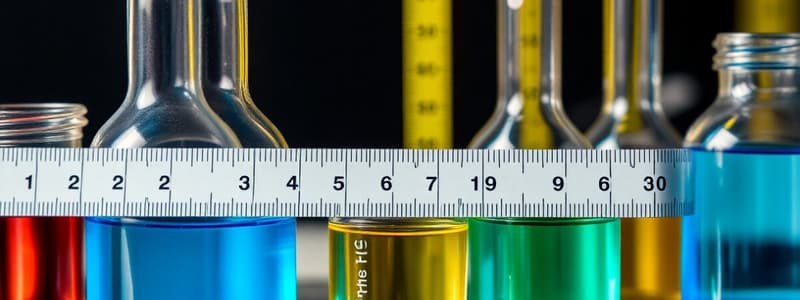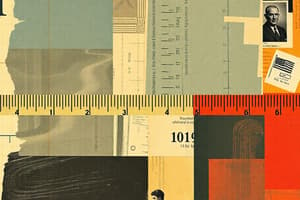Podcast
Questions and Answers
What is the primary use of units in chemistry?
What is the primary use of units in chemistry?
- To specify measurements (correct)
- To identify substances
- To describe colors
- To express opinions
Which system is used predominantly by scientists across the globe?
Which system is used predominantly by scientists across the globe?
- The Metric system
- The English system
- The SI system (correct)
- The Imperial system
In the Metric system, which unit is used to measure volume?
In the Metric system, which unit is used to measure volume?
- Cubic meter (m³)
- Millimeter (mm)
- Liter (L) (correct)
- Meter (m)
Which of the following is a measure of mass in the SI system?
Which of the following is a measure of mass in the SI system?
What unit is used for measuring temperature in the SI system?
What unit is used for measuring temperature in the SI system?
Which measurement corresponds to 'time' in both the metric and SI systems?
Which measurement corresponds to 'time' in both the metric and SI systems?
What is the smallest unit used in the metric system for measuring length?
What is the smallest unit used in the metric system for measuring length?
What is the importance of standard units of measurement in everyday life?
What is the importance of standard units of measurement in everyday life?
Which element is classified as a halogen?
Which element is classified as a halogen?
Which of the following pairs of elements would you expect to be most similar?
Which of the following pairs of elements would you expect to be most similar?
What is the predicted charge of the monoatomic ion formed by potassium (K)?
What is the predicted charge of the monoatomic ion formed by potassium (K)?
Which element is a noble gas?
Which element is a noble gas?
What describes the relationship between elements and compounds?
What describes the relationship between elements and compounds?
Which of the following elements is classified as an alkaline earth metal?
Which of the following elements is classified as an alkaline earth metal?
Which of these elements is also found in nature as a salt?
Which of these elements is also found in nature as a salt?
Which element is likely to gain three electrons?
Which element is likely to gain three electrons?
What defines an isotope of an element?
What defines an isotope of an element?
How can you determine the number of neutrons in an atom?
How can you determine the number of neutrons in an atom?
Which of the following is true about carbon isotopes?
Which of the following is true about carbon isotopes?
What distinguishes molecules from ions?
What distinguishes molecules from ions?
What is a cation?
What is a cation?
Which of the following statements about anions is correct?
Which of the following statements about anions is correct?
How many neutrons are present in the sulfur isotope S-32?
How many neutrons are present in the sulfur isotope S-32?
Which statement about molecules is false?
Which statement about molecules is false?
What defines molecular compounds?
What defines molecular compounds?
Which of the following is classified as a molecular element?
Which of the following is classified as a molecular element?
Which of the following substances is an ionic compound?
Which of the following substances is an ionic compound?
Which of these elements occurs as a polyatomic molecule?
Which of these elements occurs as a polyatomic molecule?
What is the main bonding type in molecular elements?
What is the main bonding type in molecular elements?
Which of the following is NOT considered a molecular compound?
Which of the following is NOT considered a molecular compound?
Which element is a diatomic molecule from the periodic table?
Which element is a diatomic molecule from the periodic table?
What is the characteristic feature of ionic compounds?
What is the characteristic feature of ionic compounds?
What does the law of definite proportions state about a chemical compound?
What does the law of definite proportions state about a chemical compound?
According to the law of multiple proportions, what occurs when two elements combine to form different compounds?
According to the law of multiple proportions, what occurs when two elements combine to form different compounds?
How is the identity of an element determined?
How is the identity of an element determined?
In the periodic table, elements are arranged according to which property?
In the periodic table, elements are arranged according to which property?
Which of the following statements about isotopes is true?
Which of the following statements about isotopes is true?
What is the mass ratio of chlorine to sodium in a sample of sodium chloride (NaCl)?
What is the mass ratio of chlorine to sodium in a sample of sodium chloride (NaCl)?
What does the symbol 'Fe' represent in the periodic table?
What does the symbol 'Fe' represent in the periodic table?
Which of the following compounds has a mass ratio of 1:1 for its elements?
Which of the following compounds has a mass ratio of 1:1 for its elements?
Flashcards are hidden until you start studying
Study Notes
Units of Measurement
- Units are standard quantities used to specify measurements. They are critical in chemistry.
- The English system, used in the United States.
- The Metric system, used in most countries.
- The International System of Units (SI), used by scientists, is based on the metric system.
Units in Metric and SI Systems
- The metric and SI systems use one unit for each type of measurement:
- Length: meter (m)
- Volume: liter (L) or cubic meter (m³)
- Mass: gram (g) or kilogram (kg)
- Temperature: Celsius (°C) or Kelvin (K)
- Time: second (s)
Meter: Measure of Length
- Length is measured using a meter stick.
- The meter (m) is the unit of length used in both the metric and SI systems.
- Centimeters (cm) are used for smaller lengths.
Kilogram: Measure of Mass
- Mass is a measure of the quantity of matter in an object.
- The Law of Definite Proportions (Proust): A chemical compound always contains the same elements in the exact same proportions by mass, regardless of its source or how it was prepared.
Law of Multiple Proportions
- The Law of Multiple Proportions (Dalton): When two elements combine to form two or more compounds, the ratios of the masses of those elements in the formed compounds are simple whole numbers.
- For example, carbon dioxide (CO₂) has a ratio of 1 carbon atom to 2 oxygen atoms (1:2). Carbon monoxide (CO) has a ratio of 1 carbon atom to 1 oxygen atom (1:1).
Elements: Defined by Number of Protons
- Each element has a unique name, symbol, and atomic number.
- The elements are arranged on the periodic table in order of increasing atomic number.
- Atomic number (Z): The number of protons in an atom’s nucleus, it identifies the element.
Isotopes: Varying Number of Neutrons
- Isotopes: Atoms of the same element that have the same number of protons (atomic number) but different numbers of neutrons.
- They differ in mass number (A) because they have different numbers of neutrons.
- Isotopes are chemically identical, but may be physically different.
- Mass Number (A) = Protons + Neutrons
- Isotopes are identified by their mass numbers (e.g. C-12, C-13, C-14).
Molecules
- Molecules : An electrically neutral group of two or more atoms held together by chemical bonds.
- Homonuclear molecules: consist of atoms of the same chemical element (e.g., oxygen, O2).
- Heteronuclear molecules: consist of atoms of more than one element (e.g., water, H2O).
Ions: Charged Atoms
- Ions: Formed when an atom loses or gains one or more electrons.
- Cations: formed when an atom loses one or more electrons, they are positively charged (more protons than electrons).
- Anions: formed when an atom gains one or more electrons, they are negatively charged (fewer protons than electrons).
Major Families: Halogens (Group 7A)
- Halogens: Group 7A elements, they are very reactive nonmetals.
- Always found in nature as salts.
- Examples: Chlorine (Cl2), Bromine (Br2), Iodine (I2), Fluorine (F2)
Major Families: Noble Gases (Group 8A)
- Noble Gases: Group 8A elements, they are mostly unreactive (inert).
- Examples: Helium (He), Neon (Ne), Argon (Ar), Krypton (Kr), Xenon (Xe)
Elements, Compounds and Mixtures
- Elements: The simplest form of matter.
- Compounds: Formed when two or more elements combine in a fixed ratio.
- Mixtures: Two or more substances physically combined but not chemically bonded.
Molecular Elements
- Molecular Elements: Elements whose particles are multi-atom molecules, having the same type of atoms (e.g., H2, O2, N2, Cl2, P4, S8, Se8).
Molecular Compounds
- Molecular Compounds: Compounds whose particles are molecules made of only nonmetals (e.g., H2O, NH3, HCl, CH4)
Ionic Compounds
- Ionic Compounds: Compounds whose particles are composed of cations (metals) and anions (nonmetals) (e.g., NaCl, AlF3, Fe2O3, Mg2S).
Formula Mass & Molar Mass
- Formula Mass (amu): The mass of an individual molecule or formula unit, expressed in atomic mass units (amu). Also known as molecular mass or molecular weight.
- Molar Mass (g/mol): The mass of one mole of a substance.
Studying That Suits You
Use AI to generate personalized quizzes and flashcards to suit your learning preferences.




